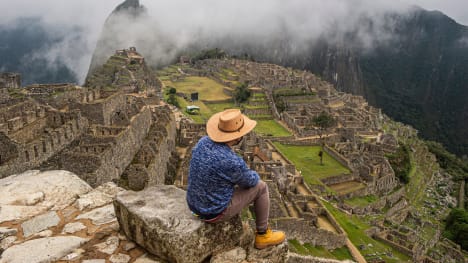(CNN) – The United States Centers for Disease Control and Prevention (CDC) has added 15 places to the list of “highest” risk factors for Covit-19, including many in Latin America and the Caribbean.
With more than 500 cases per 100,000 residents in the last 28 days, the CDC sets a target of “highest” risk level 4. The agency advises travelers to avoid traveling to Tier 4 countries.
After adding the previous 22 countries, 15 places added this week:
– Colombia
– Costa Rica
– Dominican Republic
– Fiji
– Guadeloupe
– Jamaica
– Kuwait
– Mongolia
– Niger
– Peru
– Romania
– San Bartholomew
– San Martin
– Tunisia
– United Arab Emirates
Caribbean island destinations (Dominican Republic, Guadeloupe, Jamaica, Saint Bartholomew and Saint Martin) accounted for one-third of new arrivals this week. Haiti, located on the island of Hispaniola next to the Dominican Republic, was already in Tier 4.
Other popular Caribbean destinations were already in Tier 4. These include Aruba, the Bahamas, Barbados, the British Virgin Islands, Curaக்கோao and the Turks and Caicos Islands.
The two major countries along the Caribbean coast are Costa Rica in Central America and Colombia in South America.
Machu Picchu’s Inca site is one of the most popular tourist attractions in Peru. On Monday, Peru moved to the CDC’s highest risk level for Govt-19. (Ernesto Benavitz / AFP via Getty Images)
Added to Level 4 this week, the CDC recommends other major travel destinations to avoid: Peru, located in Machu Picchu, and the United Arab Emirates, located in Dubai.
Last week, 14 of 15 goals were at level 3, which is considered the “highest” risk for Kovit-19.
Niger, a landlocked country in West Africa, is famous for its ancient caravan cities, which were in the Tier 1, which is considered a “low” hazard.
There are now almost 120 places on the Tier 4 list. Early January, There were about 80 locations, which further demonstrates the purpose of the Omigron variant.
You can view CDC’s risk levels for locations worldwide Travel Recommendations page.
The CDC did not add the United States to its advisory list, but the country was color-coded to level 4 on January 24. Travel risk level map From the agency.
Within it Great travel guide, The CDC recommends avoiding all international travel until you are fully vaccinated.
Situation in Europe
While most of the Caribbean is moving to tier 4 this week, there are weeks or months across Europe. Those places include some of the continent’s big names:
– France
– Germany
– Greece
– Iceland
– Ireland
– Italy
– Spain
– United Kingdom
Romania is the only new European addition to Tier 4 this week.
Adding to level 3

The Taj Mahal Cemetery is the iconic symbol of India and has undergone major changes due to Govt-19. Cases of omigron variant are increasing in India and it has been shifted to CDC layer 3. (Getty Images by Ludovic Marin / AFP)
Layer 3, which covers 100 to 500 cases per 100,000 residents in the last 28 days, added 10 seats this Monday:
– Djibouti
– Equatorial Guinea
– Guatemala
– India
– Japan
– Kosovo
– Kyrgyzstan
– Mali
– Republic of the Congo
– Senegal
Four locations — Equatorial Guinea in Central Africa, Japan, Kyrgyzstan in Central Asia and Senegal in West Africa — were at “low” risk level 1.
The remaining six were in Level 2.
Levels 2, 1 and unknown
Places that carry the name “Level 2: Moderate Govt-19” per 100,000 residents in the last 28 days have registered 50 to 99 Govt-19 cases. That position had two new additions this Monday.
These are Bangladesh, which was in Tier 1, and is the little sultan of Brunei that was listed as “unknown” last week.
To be in “Level 1: Low Govt-19”, there must have been less than 50 new cases per 100,000 residents in the last 28 days. No new additions were made on Monday.
China, which hosts the Winter Olympics in February, has been in Tier 1 since May 2021. This is currently one of a dozen locations in Tier 1.
Finally, there are places where the CDC assigns “unknown” risk due to lack of information. Usually, but not always, these are small, remote places or places with ongoing wars or riots. No additions this week.
Popular destinations at “unknown” risk include Cambodia, French Polynesia and Tanzania. The CDC advises to avoid traveling to these places precisely because the dangers are unknown.
Cruise ships
The The CDC includes cruise ships In your destination list.
On December 30, the CDC increased the risk of shipping to level 4 and stated that the vaccine should be avoided regardless of status. In the last update the cruisers were in Tier 4.
Meanwhile, The CDC Covid-19 guidance is optional For many ships.
The CDC Extended Conditional Navigation Order Has recently expired, and the company has switched to a volunteer program for foreign flagged cruise ships operating in US waters.
Travel Considerations
Transmission rates are important to consider when making travel decisions, but other factors need to be weighed, says Dr. Lena Wen, CNN medical researcher, emergency physician and professor of health policy and management at the George Milk Institute at the George Washington University. Public Health School.
“Exchange rates are a guide,” Wen said. “The other is to take precautions and follow where you are going, and thirdly what you plan to do when you get there.
“Do you plan to go to a lot of attractive places and go to closed bars? It’s very different than going to a place where you plan to be at the beach all day and not get acquainted with anyone else. They are very different risk levels.”
Vaccination is the most important safety factor for travel, Wen said, because unvaccinated passengers are more likely to get sick and spread COVID-19 to others.
He added that people who do not know the vaccine status should wear high-quality masks (N95, KN95, or KF94) whenever they are in crowded indoor settings.
Before you travel, it is also important to consider what you will do if you complete a positive test outside the home, Wen said. Where do you stay and how easily can you check back home?



:quality(85)/cloudfront-us-east-1.images.arcpublishing.com/infobae/VWWQ37HV5ZERLPFWQKUG6JD2CQ.jpg)
:quality(85)/cloudfront-us-east-1.images.arcpublishing.com/infobae/DVLWJKBJAVKNNQUXRVYQP4UHUY.jpg)
:quality(85)/cloudfront-us-east-1.images.arcpublishing.com/infobae/FVNTXGAGFIT3KQWJH5HYR4JCOY.jpg)